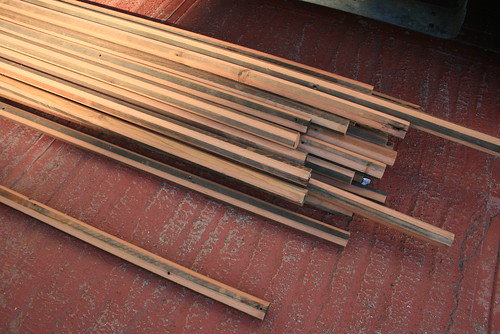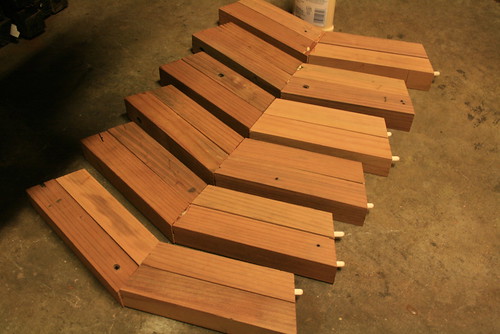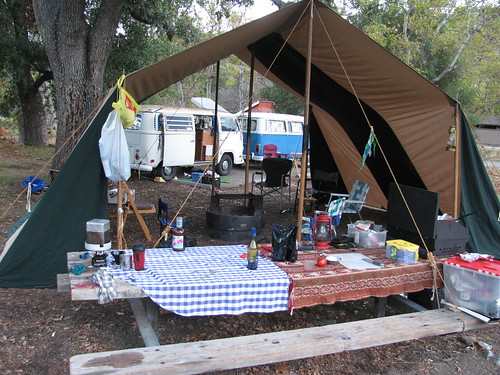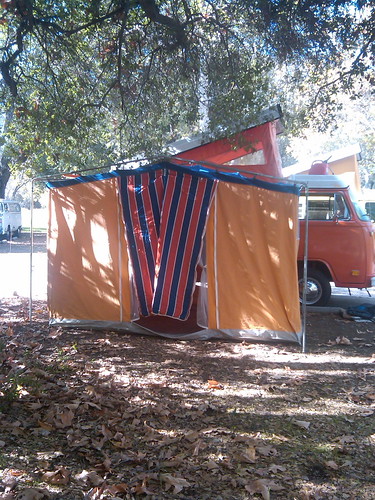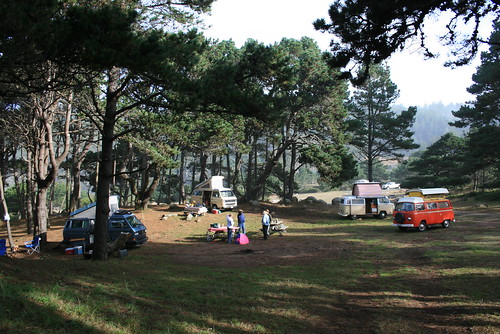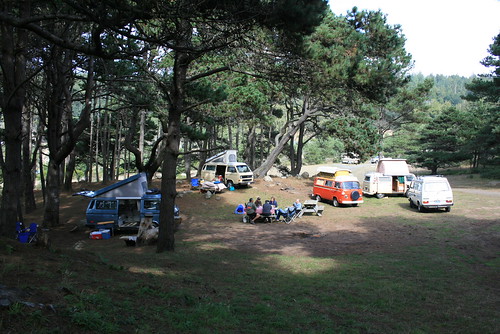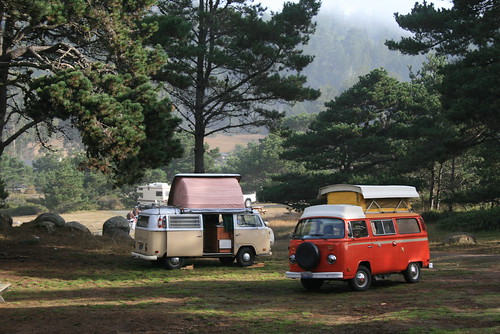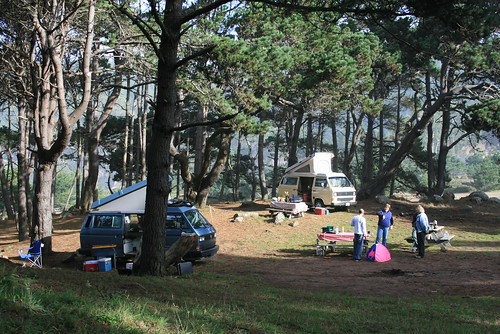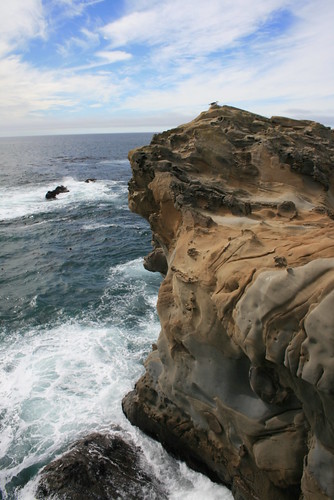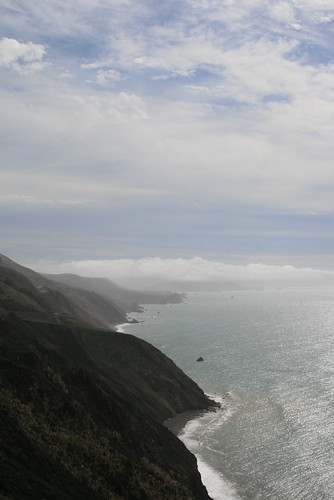After hearing so much stuff about the Lost Coast, we felt like we had to check it out ourselves. But first, we had to figure out where it was, which is actually a mystery because nowhere in California, on a map, does it say "the lost coast." Its really just a nick name for the stretch of coast where highway 1 goes inland, in the north, through Mendocino and Humboldt counties. It truly is a lost coast, since access to it is very limited. There are only about three places where you can drive a car near the ocean, and only one official town. I wouldn't actually call it a town, more like a bunch of dumpy houses that weren't swallowed up by the BLM or some other government run conservation agency (and this is almost too bad actually, because the town of Shelter Cove feels like it just doesn't belong there, to me, anyways). And with the amount of hints I just dropped about its location, I think a determined person would have no trouble finding it, so that's all I will give away - after all, I hope it remains "the lost coast."
Our journey started on Friday night. We got out of the bay area, heading north on highway 101, and we hit a traffic jam. What was unusual about this traffic jam was that it lasted a very, very long time. So long, in fact, that we had ample time to get to know our "neighbors." In California, people drive extremely conservative. They don't switch lanes, they give everybody the right of way (even when they don't deserve it) and they don't generally take risks. So the people around us at the start of the traffic jam were with us pretty much through the end of it. We had a curious jeep behind us, then next to us, then in front of us (for a while, but not for long), who could not concentrate on anything else except starring at the people and cars around him. We had a guy in front of us in a Volvo station wagon who "missed Jerry" (aka The Grateful Dead Jerry Garcia) and could not help himself but stick out his fist through his sun roof and rock out to the songs playing on his radio. Sometimes he was pointing to the sky with an index finger. Sometimes he was showing everybody he could signal the number 4 or 5 to the beat with his hand. Even the curious Jeep couldn't help but stare. We also had Miss Biodiesel in the late 70s Mercedes. You could smell her literally for miles behind! At first we though something was wrong with our baja. Nope, it was just the burning biodiesel. After a while, the traffic jam began to break up (two hours later), and we began making progress towards our destination, Humboldt Redwoods State Park, where we planned to camp that Friday night.
The last time we visited Humboldt Redwoods, in April with our friends Mark & Emma, we had a wonderful time camping under old growth redwoods for about $20/night, which was the normal price for a state-run campground back then. We expected to pull in after dark (it was about 10pm), pitch our tent, and get some sleep before we headed towards the Lost Coast the next morning. When we pulled in to the campground, we saw that the price had now increased to $35/night!!! WTF!? Suddenly it became clear that all of those California "budget" issues were really affecting us now (ignore the fact that all of the public state schools were being screwed, including UC Berkeley) but, seriously, $35? I guess that was better than the threat of closing over 200 state parks (which, thankfully was re-planned, this being one of the compromises). Since we clearly were not going to have enough time to make the $35 worth it, we decided to pitch the tent anyways, but wake up at the crack of dawn (before the campground hosts woke up, most importantly) and make a run for it before anyone knew we spent the night.
When 6:15am rolled in, we woke up, quickly packed our things, and got into the baja. Of course, being aircooled and LOUD, (we didn't want to repeat the performance, like at Mt Whitney, where we woke up all the campers at 4am to the sweet sounds of the bus starting its engine and the exhaust) we decided to push the baja quietly out of the campground. For some reason, Romy was nervous, thinking that, since the campground hosts were most likely old people, they would be up very very early, and come try to get our money for the night of camping we had not paid. I guess it was just his guilty conscious. We pushed our way through the winding loops of the campground, between towering redwoods, which looked only like large looming shadows, almost out of the place when Romy took THE WRONG TURN. And I really mean, the wrong turn, because he drove the baja straight down into a bowl - a depression - a pit, which we then had to push the baja out of!!!! Granted, the baja weights much less than the bus, but, have you ever had to push a VW Beetle up a 15% grade hill before!? Oh yeah. I forgot - the baja didn't start with the ignition. The wiring was screwed up so it wouldn't start with the key, only push starting worked. So we basically had no choice but to push it out of the depression. After the work-out of a lifetime, pushing it up the hill, we finally got it out, and then quietly out of the campground.
Since we got out so early, we had a chance to see the morning sunrise come up over the mountains of Humboldt County:
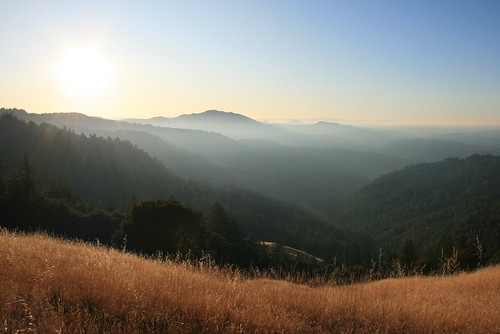
Sunrise over Humboldt County.
Heading towards the coast, we drove through the sleepy village of Honeydew (yes, like the melon) which we entered by crossing a one-lane, wooden bridge. If you blinked, you could've drove through the whole town. We noticed a one-pump gas "station" so we pulled over. It didn't open til 9am, so we hung out for a while. We were sitting right across from a farm which had two horses. A little girl took one of them and led it to the farm gate, near the road. She opened the gate, pulled the horse out, closed the gate quickly behind her (as the second horse tried to follow), and then stepped up onto the gate, hoisting herself onto her horse, riding bare-back. She rode it along the road, out off into the distance. The second horse, still left at the farm was furious. It huffed and trotted all around, super angry that its friend left. Seriously, for close to 20 minutes, all that horse did was make noises, and trot around pissed off. When the lady opened the gas station office, we paid for $20 of gas, and filled up. Then we drove off. That morning, after entering the protected area called the lost coast, we decided to take a hike along the mountain ridges along the ocean. Most of the coast of California is tectonically active, where the Pacific plate meets with the North Atlantic plate, creating a coastal chain of mountains. These mountains seem to plunge into the ocean at the lost coast. One moment, you'll be at the top of a ridge, and when you look down, you see a soft layer of white fog hovering over the ocean, swallowing the land.
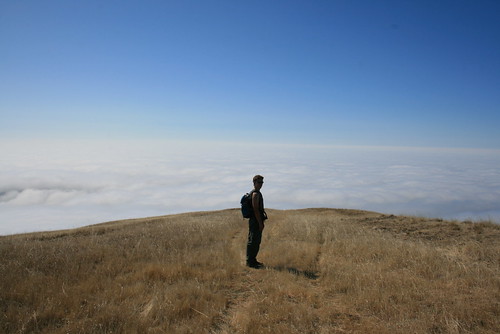
Romy above the clouds of fog.

Fog at the lost coast.
As we hiked down closer to the ocean, we met the line of fog hanging over the water. Although it was hot in the sun, the moist foggy air cooled us down pretty quickly, so we decided to eat lunch right above the fog line. It rolled past us intermittently, surrounding us in a blanket of cold white. Then it blew past, revealing our surroundings once again. We couldn't help but notice that the fog was not going to burn away under sun, so we went back up the mountain ridges, heading back to the trailhead where we parked the baja.
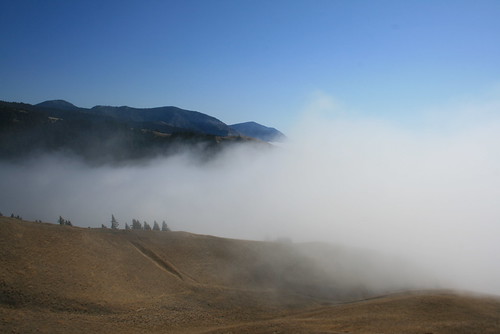
Fog rolls in at lunch.
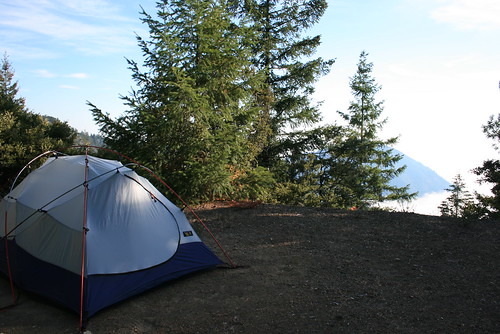
Camping at the lost coast.
Once back in the car, it was already past 4pm. Since it would be dark in just a few hours, we needed to find a campsite! Luckily, since we were on BLM land (Bureau of Land Management) we were allowed to camp anywhere we desired. The BLM is a government agency which owns and protects public lands in the US, predominantly in the western parts of the country, similar to a National Forest, or a National Park but with much less rules and restrictions (or entrance fees). While driving in, we saw a really big and secluded place to pull of the dirt road, so we back tracked to that spot hoping nobody found it. Actually, while we were there, in the protected area of the lost coast, I saw a total of 3 people, 2 of which were hiking and camping out on the beach, so I didn't really think anybody would've taken our campsite. Anyways, we found it unoccupied, so we settled in, pitching our tent and cooking dinner. This was the view from our campsite:
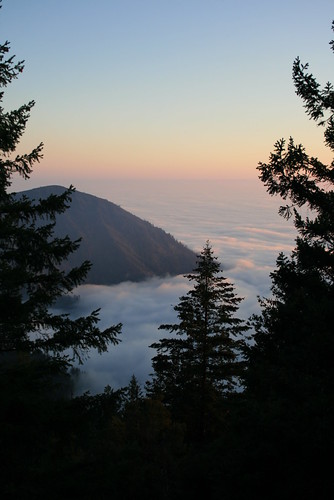
View from our campsite.
We were perched on a mountainside overlooking the ocean. Of course, you can't actually see the water because it is covered in marshmallow fluff (fog). And oddly, as the night progressed, it seemed to be getting warmer and warmer outside. There was a warm breeze in the air. As the sun went down, we turned on the radio and scanned the channels, ultimately deciding on listening to
KMUD redwood community radio, a local radio station based out of nearby Redway, California. It was reggae hour. Every commercial they played had something to do with marijuana, be it advertisement for a medical-marijuana friendly doctor's office, or for a hydroponics shop in the area. Even the radio DJ was high, but you wouldn't expect anything less out of a radio station broadcasting from Humboldt County, the place where the most marijuana is grown in the whole western half of the country!

A foggy morning over Humboldt County.
I honestly thought that a black bear was going to raid our campsite in the night. No such thing happened, but in the morning I heard a lot of rustling outside (probably some birds, only) so it woke me up. Of course, it was nothing. Sadly it was already Sunday, so time to start heading back south. We drove along the dirt roads through the lost coast protected area, until we hit Shelter Cove. Then we headed inland to Garberville. Garberville lies along hwy 101, so we got onto the highway and decided to stop by the "Legend of the Bigfoot" store. Who doesn't stop there? How can you not resist the wooden chain-saw carvings of wild animals, and of all things, Shrek characters?
It was a good thing we did stop, because the baja had a slow leak at the tire valve stem. Our tire was about half-flat. Luckily we had a spare, which we changed, and then went back to Garberville to find a tire shop which would replace the valve stem. No such luck, so we continued on to nearby Redway. We were extremely lucky to find Redwood Tow & Repair shop, who weren't really open, but the young guy employee left the garage door up, so we pulled in. He changed our valve stem for only $11 (which involves breaking the seal between the tire and the rim, and then resealing it) so it was all around a great deal. After that, we continued home, south. It got cloudier and cloudier, like some impending doom. The doom was probably that Monday was coming! :-)

Redwood Tow & Repair
